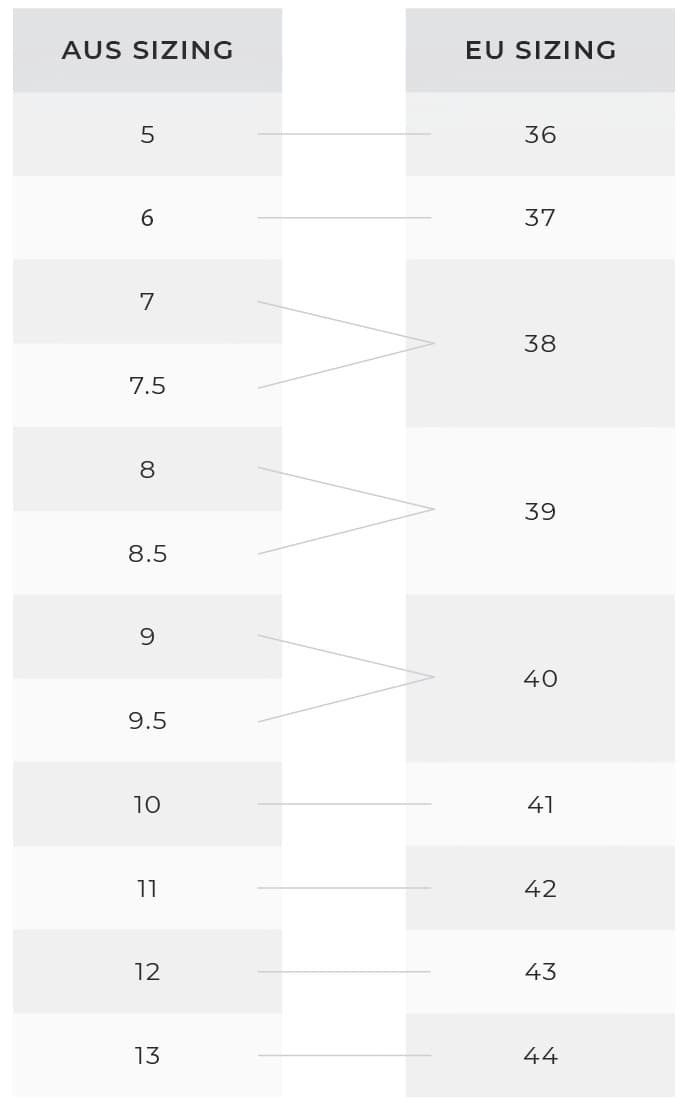A Comprehensive Guide to Australian to US Shoe Size Conversion for Parents
Hey there, savvy parents! Are you on a mission to find the absolute perfect fit for your child’s growing feet, specifically converting from Australian to US shoe sizes? Look no further! We understand that shoe shopping for kids can seem like an episode of “Mission: Impossible,” especially when dealing with different international sizing standards. So, we’re here to demystify the puzzle with our ultimate guide to shoe size conversion between Australia and the US.
Understanding Shoe Size Differences
Before we dive into charts and numbers, let’s have a chat about why shoe size conversion is even a thing. You see, different countries have their own methodologies for measuring and standardising shoe sizes. The length and width of a child’s foot in Australia might be represented differently when compared to the US sizing, similar to how one country uses kilometers and another uses miles. But don’t fret! Our guide will serve as your trusty roadmap, steering you from the Land Down Under to the Stars and Stripes with ease.
Getting the Right Measurement
First things first—meticulously measure those tiny tootsies! Accurate measurements are the key to making this international shoe size exchange work. You can use a standard ruler, a printable shoe size chart, or even better, visit a professional shoe fitter. To ensure a perfect fit, always measure both feet as one might be slightly larger than the other and use the measurements from the larger foot when choosing shoe sizes.
Australian to US Kids Shoe Size Chart
Now, let’s get down to business. We’ve crafted a detailed Australian to US shoe size chart to simplify your shopping experience. For easy reference, here’s how the sizes typically translate:
- For infants and young children, US sizes are approximately 2 sizes larger than Australian sizes.
- For older children and teens, the difference narrows to about 1 or 1.5 sizes.
Below is a handy table with some common conversions:
| Australian Size | US Size (Boys) | US Size (Girls) | Foot Length (inches) | Foot Length (centimeters) |
|---|---|---|---|---|
| 5 | 7 | 7 | 5.1″ | 13 |
Don’t forget, children’s feet grow faster than a cheetah sprints, so it’s essential to check their shoe size every few months. For the best results, let’s avoid going solely by size labels and focus instead on the measurements and how the shoes fit.
Checking the Fit
Once you’ve locked down those US sizes and picked out some stylish kicks, ensure the shoes pass the fit test. Leave a thumb’s width (around half an inch) between your child’s big toe and the shoe’s end to allow for some wiggle and growth room. Also, ensure no part of the shoe is pinching or squeezing—comfort is king!
Remember, every shoe brand may have slight variations in sizing, and like adults, your little one might find one brand fits differently from another. The golden rule: always try before you buy, whenever possible, or check for online retailers with generous return policies.
Staying armed with this knowledge on Australian to US shoe size conversion will turn your shoe shopping from a dreaded chore into a delightful adventure. Remember that the journey to finding the perfect fit is all part of watching your child step confidently into new experiences—literally! So, grab your measuring tape andlet’s start this size-converting safari!

5 Essential Tips for Parents Preparing for Australian to US Shoe Size Conversion
Shoe size conversion doesn’t have to be a brainteaser. Here are five golden nuggets of advice to keep in mind when dealing with Australian to US shoe size conversion for your kiddos:
1. Consistently Update Measurements
Kids grow at warp speed, and so do their feet. Make sure to measure your child’s feet every two to three months for toddlers and every four to six months for older children. Staying up-to-date with their current size ensures you’re always ready for that next size up.
2. Understand the Sizing Increments
Australian sizes increase by about one-third of an inch for each full size, while US sizes grow by approximately one-eighth of an inch for half sizes and one-fourth of an inch for full sizes. Grasping these increments can help you predict the next size your child might need.
3. Know the Brand’s Sizing Quirks
Some brands run big, some run small, and others are just right. It’s like the story of Goldilocks, but with shoes! Hence, get familiar with the brands your child likes and how their sizes compare to others, ensuring a better fit every time.
4. Be Mindful of Different Foot Widths
Size isn’t all about length; width matters too! Make sure you’re considering the width of your child’s feet. Kids can have narrow, medium, or wide feet which affects their shoe size. Look for brands that offer a variety of widths to accommodate those little paws perfectly.
5. When in Doubt, Go Larger
If you’re on the fence and debating between two sizes, it’s generally safe to go a tad larger. This gives your child room to grow, and as any parent knows, they’ll be doing plenty of that. Just ensure the shoes aren’t too roomy as this can cause tripping or discomfort.
Keep these tips in the forefront of your mind and you’re sure to conquer the great shoe sizing challenge with a smile on your face and a spring in your child’s step!
Expanding the Shoe Size Chart
Because we know how vital this information is, let’s expand our chart to cover more shoe sizes. This way, you’ll be equipped with the intel you need no matter the size of those twinkle toes.
| Australian Size | US Size (Boys) | US Size (Girls) | Foot Length (inches) | Foot Length (centimeters) |
|---|---|---|---|---|
| 5 | 7 | 7 | 5.1″ | 13 |
| 6 | 8 | 8 | 5.5″ | 14 |
| 7 | 9 | 9 | 5.9″ | 15 |
| 8 | 10 | 10 | 6.3″ | 16 |
| 9 | 11 | 11 | 6.7″ | 17 |
Add this new knowledge to your shopping tool belt, and you’re sure to be prepared for any shoe-hunting expedition. Embrace the process and remember, when in doubt, measure, compare, and be prepared to return for the best fit possible. Happy shoe sizing!
For more great articles please see here. For more information see here
Disclaimer
The articles available via our website provide general information only and we strongly urge readers to exercise caution and conduct their own thorough research and fact-checking. The information presented should not be taken as absolute truth, and, to the maximum extent permitted by law, we will not be held liable for any inaccuracies or errors in the content. It is essential for individuals to independently verify and validate the information before making any decisions or taking any actions based on the articles.




